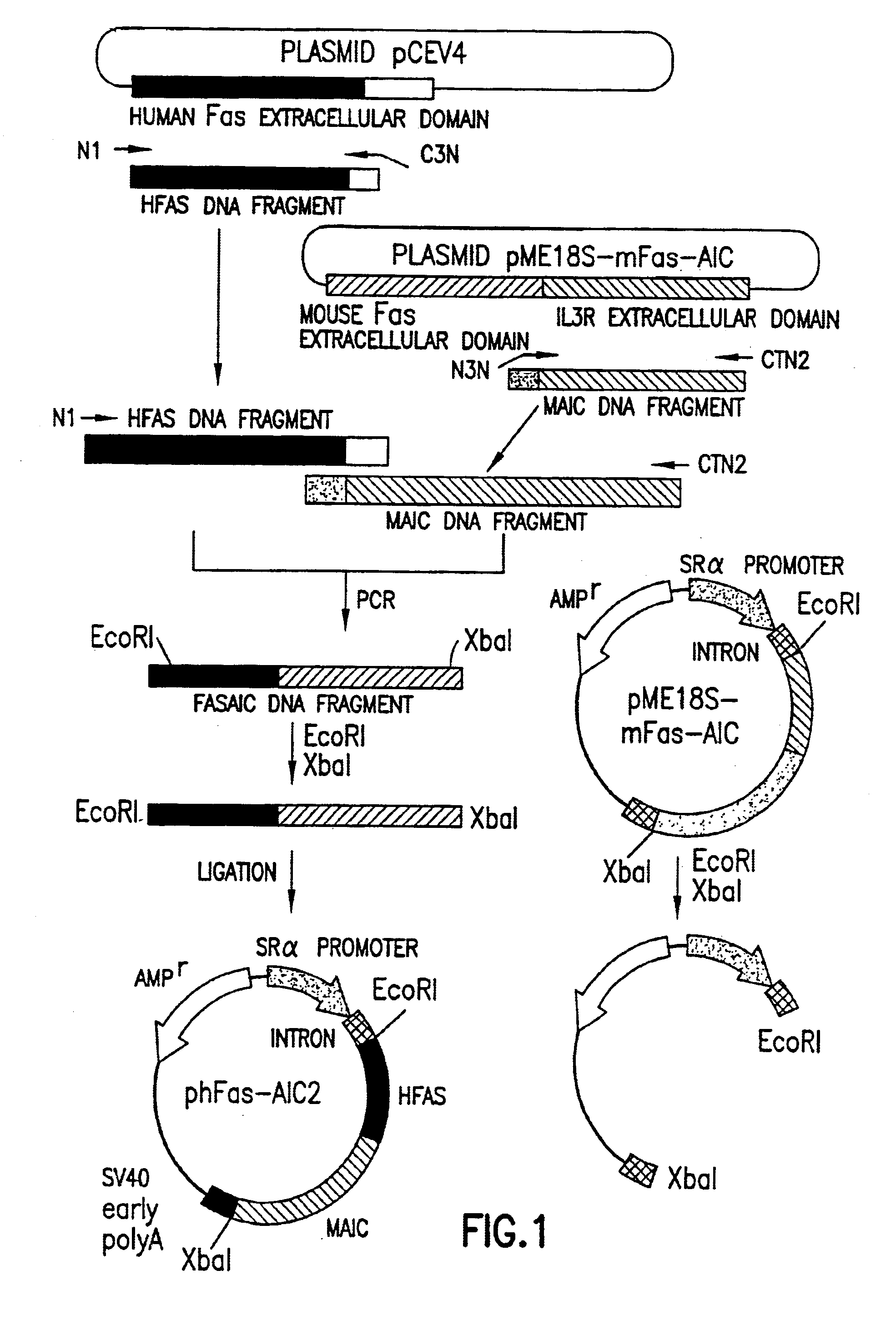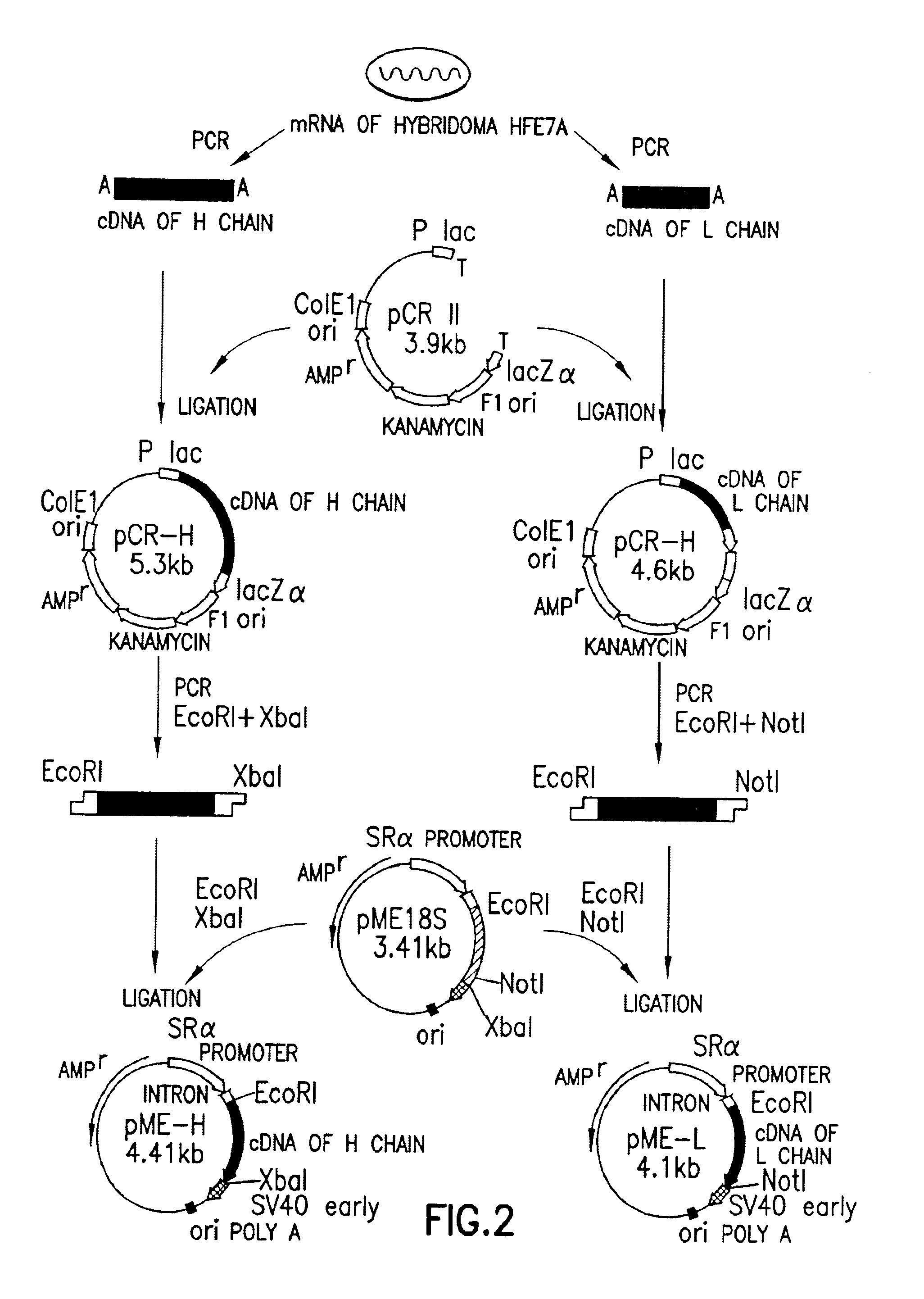Anti-Fas antibodies
a technology of antibodies and antibodies, applied in the field of humanized antibodies, can solve the problems of chronic renal failure, pathological loss of filtering function, critical shortage of insulin secretion,
- Summary
- Abstract
- Description
- Claims
- Application Information
AI Technical Summary
Benefits of technology
Problems solved by technology
Method used
Image
Examples
reference example 1
Preparation of Fas Antigen
[0334]In order to obtain a soluble version of human Fas lacking the transmembrane domain, an expression vector was constructed. This vector was designed to encode a fusion protein (the “Fas fusion protein”) comprising the extracellular domain of human Fas fused to the extracellular domain of the mouse interleukin 3 (IL3) receptor [c.f. Gorman, D. M. et al., (1990), Proc. Natl. Acad. Sci. USA, 87, 5459-5463]. DNA encoding the human Fas fusion protein was prepared from this vector by PCR. The construction of the vector and preparation of DNA was as follows.
a) Template
[0335]The templates used for the PCR to construct the insert encoding the fusion protein were two plasmids. The first plasmid, pME18S-mFas-AIC [c.f. Nishimura, Y. et al., (1995), J. Immunol. 154, 4395-4403], was a DNA expression plasmid vector encoding a fusion protein, comprising the extracellular domain of mouse Fas and the extracellular domain of the mouse IL3 receptor. The second plasmid, pCE...
reference example 2
Immunization of Mice and Preparation of Hybridoma
(2-1) Immunization
[0384]A sample of 1 ml of the crude human Fas fusion protein solution obtained in Reference Example 1 above (total protein: 100 μg) was taken and, to this, were added 25 μl of 2N HCl. 250 μl of 9% w / v potash alum (final concentration: 1.1% w / v) and 25 μl of 2N NaOH. The resulting mixture was adjusted to a pH of between about 6.5 and 7.0 by the addition of about 120 μl of an aqueous solution of 10%(w / v) sodium hydrogencarbonate and left to stand at room temperature for about 30 minutes. After this time, 200 μl of killed Bordetella pertussis (Wako Pure Chemical Industries, Ltd.; 1.2×1011 cells / ml) were added to the mixture in order to activate the T cells, and the mixture was administered intraperitoneally to a Fas knock-out mouse. The mouse used was prepared in accordance with the method described by Senju et al. [c.f. Senju, S. et al., (1996), International Immunology, 8, 423]. The mouse was given an intraperitoneal ...
reference example 3
Purification of HFE7A Monoclonal Antibody
[0396]The mouse-mouse hybridoma HFE7A obtained in Reference Example 2 (FERM BP-5828) was grown to a cell density of 1×106 cells / ml by incubation in 1 l of ASF medium, containing 10% v / v FCS, at 37° C. under 5% V / v CO2. The culture was then centrifuged (1,000 r.p.m., 2 minutes) and the supernatant discarded. The cell pellet was washed once with serum-free ASF medium, suspended in 1 l of serum-free ASF medium and incubated for 48 hours at 37° C. under 5% v / v CO2. After this time, the culture was centrifuged (1,000 r.p.m. for 2 minutes) to recover the supernatant. This supernatant was then placed in a dialysis tube (exclusion m.w.: 12,000-14,000; Gibco BRL), and dialyzed against 10 volumes of 10 mM sodium phosphate buffer (pH 8.0). Partial purification of IgG from the inner solution was achieved using a high performance liquid chromatography apparatus (FPLC system; Pharmacia) under the following conditions:[0397]column: DEAE-Sepharose CL-6B colu...
PUM
| Property | Measurement | Unit |
|---|---|---|
| v/V | aaaaa | aaaaa |
| temperature | aaaaa | aaaaa |
| temperature | aaaaa | aaaaa |
Abstract
Description
Claims
Application Information
 Login to View More
Login to View More - R&D
- Intellectual Property
- Life Sciences
- Materials
- Tech Scout
- Unparalleled Data Quality
- Higher Quality Content
- 60% Fewer Hallucinations
Browse by: Latest US Patents, China's latest patents, Technical Efficacy Thesaurus, Application Domain, Technology Topic, Popular Technical Reports.
© 2025 PatSnap. All rights reserved.Legal|Privacy policy|Modern Slavery Act Transparency Statement|Sitemap|About US| Contact US: help@patsnap.com



